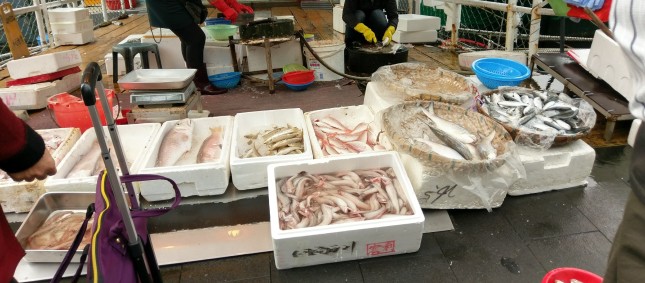Putting a Lid on Fish Boxes and Other Foamed Polystyrene Marine Debris
Where the murky brown waters of the Pearl River meet the opaque green South China Sea, a trail of floating plastic debris is gathered by the currents as they flow past Macao, Shenzhen, and Hong Kong. I first noticed this floating litter while standing on the deck of a research vessel in 2017, scanning the waves off the western coast of Lantau island for signs of Indo-Pacific humpback dolphins as part of a monitoring program run by the Hong Kong Dolphin Conservation Society. A glimpse of these rare animals was often overshadowed by the foamed polystyrene pollution (also known as expanded polystyrene (EPS) or by the proprietary name Styrofoam) from fish boxes and fishing buoys. And this was not just a problem in the water; as we conducted surveys between Hong Kong’s islands, we passed beaches covered in white plastic, strewn along the shoreline like snow.
Two years later, on the other side of the world, I was again supporting a marine mammal research program, this time in the Madeira archipelago. I explored the rocky coastline to pass the hours between surveys, but was dismayed by the amount of plastic debris—including many foamed polystyrene buoys and floats—that washed up there, 500 kilometers from the nearest continent.
Efforts to study and protect marine life face complex challenges and must overcome multiple anthropogenic pressures for which there are no straightforward solutions—overexploitation of marine resources, destructive fishing practices, ghost gear, development and habitat loss, and the effects of climate change, to name just a few. These hugely complex problems are compounded by the further harm of plastic litter, which has become pervasive throughout the marine environment. Ironically, some of this pollution comes directly from maritime activities which depend on healthy seas in the first place.
In recent years, societies have woken up to the scale of the marine plastic pollution issue. Governments worldwide are taking initial steps towards dealing with the specific problem of foamed polystyrene pollution, for example by banning takeaway containers and polystyrene cups. However, these land-focused interventions do not address the types of marine sources of polystyrene pollution that I saw almost every day in the mid-Atlantic and the South China Sea.
Puffed-up Polystyrene: Lightweight Material with Heavy Ecological Punch
Foamed polystyrene is one of the most common components of marine litter found floating at sea or washed up along coastlines. A popular choice for packaging and insulation on land, polystyrene pollution also comes directly from products used in and on the ocean, in fisheries and aquaculture (buoys, floats, and fish boxes), ports and marinas (pontoons and floating infrastructure), and leisure activities (such as surf and bodyboards). But foamed polystyrene can pose a serious threat to ocean life as it crumbles into thousands of puffed fragments in the marine environment and causes a range of health problems when ingested by wildlife, including digestive obstructions, pseudosatiation (a false sense of fullness that can lead to starvation), and reduced fertility. Already inherently toxic, polystyrene is often treated with additional chemicals like flame retardants, and absorbs pollutants from the sea, increasing the chemical threat it poses to wildlife the longer it is adrift.
Given the threats to marine biodiversity, and the direct risk of pollution from polystyrene products used at sea, Fauna & Flora International (FFI)—where I now work as a Marine Plastics Programme Officer—has compiled an initial report identifying the ways in which foamed polystyrene products are used in marine activities, how they contribute to ocean polystyrene pollution, and pathways to reduce the problem.
Complex Problems Require Comprehensive Solutions
While the research was largely UK-focused, this FFI report also examines cases of significant foamed polystyrene pollution from aquaculture and fisheries in Chile, Canada, Japan, South Korea, Taiwan, and Vietnam. Our conversations with numerous stakeholders highlighted that one of the challenges of reducing foamed polystyrene use at sea is simply how well-suited and versatile it is for these purposes. It is easy to mould, impact resistant, waterproof, buoyant, and an effective insulator. Unfortunately, some of these same properties leave foamed polystyrene vulnerable to weathering by waves, bad weather, and UV exposure, and to breaking up after being burrowed into by wildlife.
Foamed polystyrene is inexpensive to produce, making it more convenient to treat items as disposable and replace them, rather than care for them to prevent loss or damage. Its high volume-to-weight ratio also makes bulky foamed polystyrene waste awkward and costly to collect and recycle. Long periods of use at sea often contaminate foamed polystyrene products, making them impossible to recycle. And better alternatives are hard to find, with high costs preventing investment in more durable products.
Driving Effective Change at Scale
Practical steps to reduce the risk of pollution are possible, but current efforts do not go far enough. Some parts of the United States and Canada have introduced laws requiring more robust design of buoys, floats, and pontoons, with hard plastic covers over any exposed polystyrene to protect it from weathering. In Taiwan, oyster aquaculture is prohibited during the typhoon season, when floats can be damaged and dispersed by bad weather. Elsewhere, alternative materials are being trialled for fish boxes in Scotland; compressors are being installed in some fish markets to make handling of foamed polystyrene easier for recycling, such as at Aberdeen Harbour, Hong Kong; and the European Union is setting targets and encouraging innovation for more effective ways to recycle foamed polystyrene at scale. At least two international initiatives—the intergovernmental Baltic Marine Environment Protection Commission (HELCOM), and OceanWise in the North Atlantic—are exploring the issue of marine foamed polystyrene pollution and its potential solutions. While these represent important steps forward, there is a need to engage policymakers, maritime sectors, and research and development on both local and international scales to work together on this issue if we want to achieve real progress.
FFI has identified a suite of recommendations to ramp up efforts to address pollution from marine uses of foamed polystyrene. In some cases, substitution of polystyrene with more durable materials may be the best route, although full life-cycle analyses of any alternatives is needed to ensure one problem is not replaced by another. Improving product design and in-use care, and making it easier to dispose of foamed polystyrene responsibly are other key actions. We also recommend increasing awareness of the issue of foamed polystyrene pollution and its impacts among those who use it in the marine environment, to encourage wider engagement and support for tackling the problem and catalyze meaningful change.
Effective measures to tackle this issue need to be adopted at scale, so that people and wildlife can live, work, and play on the ocean without broken up foamed polystyrene choking the marine habitats on which so many species—including our own—depend.
Annkathrin Sharp is the Marine Plastics Programme Officer at Fauna & Flora International, where her work involves engaging with corporate, NGO, and policy stakeholders on evidence-based best practice, and supporting regional work with colleagues and partners internationally. With a background in foreign languages, she has an MSc in Conservation Science and has worked on marine mammal research and conservation in Asia and the Atlantic.
Sources: Baltic Marine Environment Protection Committee, Fauna & Flora International, OceanWise, Oriental Daily
Lead Image Credit: Foamed polystyrene fish boxes in use at Aberdeen Harbour, Hong Kong, courtesy of the author, Annkathrin Sharp.
Source:
Putting a Lid on Fish Boxes and Other Foamed Polystyrene Marine Debris






